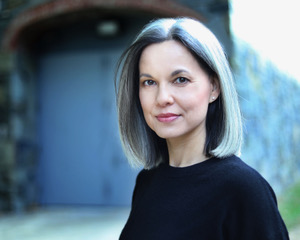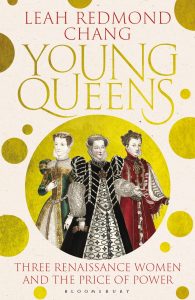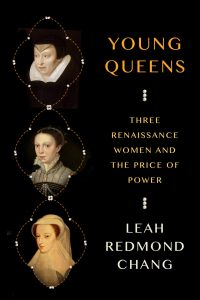Talking About Women’s History: Three Questions and an Answer with Leah Redmond Chang
Leah Redmond Chang is a former Associate Professor of French literature and culture at The George Washington University. Her writing draws on her extensive experience as a researcher in the archives and in rare book libraries. Previous books include Into Print: The Invention of Female Authorship in Early Modern France, which focused on women and book culture in the sixteenth century, and (with Katherine Kong) Portraits of the Queen Mother, about the many public faces of Catherine de’ Medici. Her next book, Young Queens: Three Renaissance Women and the Price of Power, will be published by Bloomsbury in the UK (May 2023) and Farrar, Straus and Giroux in the US (August 2023). She lives with her husband and three children, and divides her time between Washington DC and London.
Take it away, Leah!
In your coming book, Young Queens, you write about three fascinating women. Do you have a favorite among them?
Not an easy question! Young Queens follows the intertwined lives of three sixteenth-century women: Catherine de’ Medici, her daughter Elisabeth de Valois, and her daughter-in-law, Mary Stuart, also known as Mary, Queen of Scots. I like them all for different reasons, but if pressed, I would have to say that Catherine de’ Medici is my favorite. She has an unfair advantage in some ways: Catherine was the power behind the French throne until her death in 1588 at age sixty-nine, whereas her daughter Elisabeth died young at twenty-two years old. Mary, Queen of Scots, as many people know well, fled Scotland at twenty-five only to become the prisoner of Elizabeth I of England. Her imprisonment lasted until her death, at forty-four, in 1587. Perhaps it’s easier for me to like Catherine because she lived the longest and moved around the most, filling many different roles during her lifetime. She also wrote thousands of letters, so we have an incredibly rich record of her life and policies. And yet, she remains less known than a woman like Mary, Queen of Scots. That intrigues me.
Catherine was always a little bit of an underdog – and I love an underdog. An orphan practically from birth, a ‘commoner’ in the eyes of the French nobility, the unloved bride of a second son – certainly as a young woman, she seemed unlikely to become so powerful. Yet it’s the adversity Catherine faced in her youth that made her strong. Catherine was a survivor, unlike Mary, Queen of Scots who, although the ‘it’ girl at the French court during her adolescence, didn’t possess Catherine’s grit. To be fair to Mary, though, in some ways she was set up to fail, and had little reliable support once she returned to Scotland at the age of eighteen. And she made such bad choices. Could she have avoided them? Every time I retrace her story, I kind of wish she could have.
I’ve often wondered what Elisabeth de Valois would have become had she lived beyond the age of twenty-two. She was very close to her mother, and Catherine had trained Elisabeth well. It was clear by Elisabeth’s teen years that she had the talent to develop into a canny political player. The tragedy, from a historian’s perspective, is that she didn’t live long enough to see it through. That she died trying to fulfill a queen’s first duty: to provide an heir for the kingdom. And that she suffered so much trying to be both a good wife and good daughter, queen of one kingdom and royal princess of another.
You can probably sense me weighing my answer here – even as I type this, I’m running through the lives of these women, assessing what appeals to me about them. In the end, though, I still return to Catherine. She was such a complex woman, and her legacy is equally complex. She’s always had a notorious reputation despite the many efforts by scholars to recuperate her image and reveal her astute political mind. From my first encounters with Catherine, I was a bit suspicious of that ‘bad girl’ image. But Catherine wasn’t exactly an innocent victim of baseless calumny, either. She had strengths and she had weaknesses; she did both good and bad things. In short, she was a real human being, with all the baggage that comes from being human. I think that’s what I love about her: in her complexity, Catherine allows us to see the real woman behind the crowned queen.
You are writing about women who were powerful and well-known in their own time. Are there special challenges in researching such women?
There are several challenges, but I’ll focus one here. I consistently run into the problem of reliable evidence. Sixteenth-century Europe was awash in propaganda. A lot of social dynamics and tensions in the sixteenth century will seem familiar to those of us living in the twenty-first: countries torn apart by civil strife, a hardening ‘right’ and ‘left’ with diminishing hopes of breaching the divide, the rapid growth of new technology and media that enabled voices to proliferate in the public sphere, something akin to religious ‘wokeness,’ and many misogynist voices raised against women in power. These are exactly the conditions that encourage the amplification of fake news, especially about a woman who wields any kind of authority. So how do you get to the ‘truth’?
Catherine de’ Medici and Mary Stuart were both fervently adored and deeply despised during their lifetimes. Years ago, when I first started working on Catherine de’ Medici, a scholar warned me that there is no objective account of her. I found this largely to be true: it is very hard to parse fact from fiction both in sixteenth-century sources and in those produced during the centuries that have followed. To a certain extent, the same can be said of Mary. I think any book on either of these queens has to take a historiographical stance: how are you going to tell this story? How does one do justice to these women who have so many ‘lives’ in the sources? Who have taken on such mythical proportions in the cultural imagination that it’s easy to lose sight of them as living, breathing human beings?
Elisabeth de Valois is a slightly different story. She was beloved by her kingdom. No one had anything bad to say about her. But this too can become a problem. Everyone loved her a bit too much – the praise can become a little inflated. Luckily, we have sources that do give us a more rounded, intimate portrait of her – my favorites are letters and accounts by her ladies-in-waiting. And from those letters we also catch a glimpse of Elisabeth’s inner life.
That said, the letters by the ladies-in-waiting were difficult to wade through. Elisabeth was well-educated for a noblewoman in her day; her ladies weren’t always. The spelling! Oh, the spelling! As it was, sixteenth-century French spelling wasn’t codified. But these ladies often spelled phonetically. Sometimes it took me several passes through the letters to figure out what they were saying at all, let alone analyze the nuances of it.
How would you describe what you write?
I write narrative history, with an emphasis on ‘narrative.’ The two books I wrote before Young Queens were quite scholarly, and I really enjoyed researching and writing them. But I’ve always been interested in writing narrative history and exploring how scholarship could be brought to readers through story.
Growing up, I loved history, and I loved fiction. I especially loved books that blurred the line between ‘history’ and ‘fiction’ (as a child, I was obsessed with the ‘Little House’ series for that reason). I still remember my history teacher in 9th grade: at the start of every class, Ms. Smith would come out from behind her desk, perch herself on the edge, and tell us a story. That was her entry into the material, and I would always bring those stories home to the dinner table. In college, I majored in an interdisciplinary program that focused on history, literature, and philosophy, and when it came time to apply to graduate school, I ended up applying to PhD programs in both history and comparative literature. Eventually, I decided to go with comparative literature with the rather naïve idea that I could work in both disciplines under that umbrella. Although that wasn’t entirely the case, comp lit did allow me to think outside of traditional disciplinary boundaries.
As a literature scholar, I have always been very archival in my research. I’ve always wanted to handle the objects of the sixteenth century and to use them to understand the culture and the people. Though I’ve left the university in an official capacity, I’m still archival, but now I’m more focused on trying to capture the inner lives of the people I study and translate those lives to the page. I try to think about story arc and about historical actors as characters. I also like the challenge of working with and around historiographical limitations: how do you create scene and story when you must respect what the archive gives you? To me, that question makes the whole endeavor exciting. I guess you can say that I love the craft.
- The British version
- The U.S. version
(They’re both so pretty! )
A question from Leah: Across your books, you cover a lot of ground both geographic and temporal. How do you land on your subjects? What makes you say ‘Yes! This is the woman / women I’m going to write about’?
There is no simple answer to that.
In the case of Women Warriors, the general topic caught my imagination at an early age but I didn’t start thinking about it in an orderly way until years later, when Antonia Fraser’s Warrior Queens came out. After that, it seemed like I ran across examples of historical women who fought everywhere and I started to collect their stories in a casual way. When it was time to write the book, I had hundreds of examples, and I continued to find more as I worked on the book. At that point, it was a matter of making hard choices because I wanted women from different times and different places and who fought for different reasons.
For my current book, the subject literally turned up in my news feed and wouldn’t let go of my imagination.
Ultimately, I think subjects find me.
***
Want to know about Leah Redmond Chang and her work?
Check out her website: leahredmondchang.com
Subscribe to her newsletter: leahredmondchang.substack.com (Consistently interesting <<Pamela sharing an opinion.)
***
Come back tomorrow for three questions and lots of answers with the women who host the Women Who Went Before podcast.







